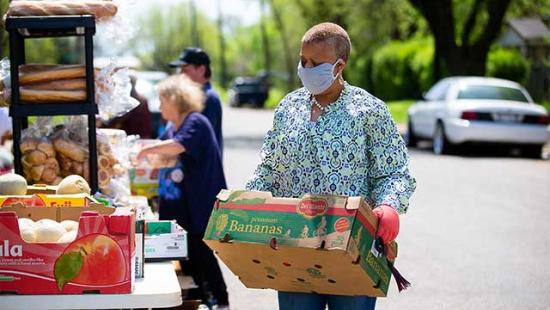

While much has been written about the impact of the COVID-19 pandemic on urban centers and suburbs across the United States, less discussed is its impact on rural America, specifically the rural West. The Rural West Covid Project, led by Justin Farrell, associate professor of sociology at the Yale School of the Environment, aims to close that data gap and provide policymakers and others with new information on rural Westerners’ response to the COVID-19 pandemic.
“Economic relief programs that are designed to help get people back on their feet might not be well-tailored to rural areas if they don’t have information about those rural communities to begin with,” says research team member Kathryn McConnell, a YSE PhD candidate.
The team recently published a paper in the Proceedings of the National Academy of Sciences (PNAS) with J. Tom Mueller from Utah State University as first author. In it, the researchers presented the results of their first survey of rural western residents, administered from June to July 2020 by numerous methods including mail, text, and phone. Over 1,000 participants, including populationally representative samples of Latinx and Native American respondents from 11 western states, were asked questions about changes to their health, economic situation, and overall well-being due to the pandemic.
“Economic relief programs that are designed to help get people back on their feet might not be well-tailored to rural areas if they don’t have information about those rural communities to begin with,” says research team member Kathryn McConnell, a YSE PhD candidate.
The team recently published a paper in the Proceedings of the National Academy of Sciences (PNAS) with J. Tom Mueller from Utah State University as first author. In it, the researchers presented the results of their first survey of rural western residents, administered from June to July 2020 by numerous methods including mail, text, and phone. Over 1,000 participants, including populationally representative samples of Latinx and Native American respondents from 11 western states, were asked questions about changes to their health, economic situation, and overall well-being due to the pandemic.
Among the survey results:
- Twenty-eight percent of respondents had a least one form of direct experience with Covid-19 and 52 percent of respondents reported some level of negative impact to their life.
- One in five people who were full-time employees before the pandemic started were no longer employed full-time when they filled out the survey. This corresponds to a 9.74 percent increase in unemployment.
- Before the pandemic, only three percent of respondents reported using unemployment benefits, but at the time of the survey that had risen to 12 percent. This increase was spread across the survey population, with no significant differences in usage associated with gender, age, education, or ethnicity.
The survey results indicate that there are more similarities than differences across groups and that the impacts from the COVID-19 pandemic are widespread across the rural West. Surveying a diverse sample of the rural West population allowed the team to compare results between gender, age, education level, and Latino/Latina and non-Latino/Latina.
“Unlike the common portrayal of rural Western America as a place that is essentially white, the reality is that the rural West is incredibly diverse,” says research team member and YSE PhD candidate Paul Burow. “We designed a survey that could capture the diversity… and how people were impacted.”
The team is currently preparing the second round of the survey which they plan to administer in the spring before vaccination is widespread and which they hope will provide time series data for how things have been changing over the course of the pandemic.
“There are some big takeaways for policymakers from this research. One is that preexisting structural conditions are profoundly impacting rural communities,” Burow says. “The problems that already existed in rural areas like limited healthcare access come to profoundly matter in context of the pandemic.”
In future work, the Rural West Covid Project team also plans to examine how rural communities in the West recover from the pandemic and how people’s sense of community has changed. This aspect of the research will focus on “people’s sense of well-being and how they feel connected to one another,” Burow says.
The work of the Rural West Covid Project was funded by a National Science Foundation rapid response research grant.
“Unlike the common portrayal of rural Western America as a place that is essentially white, the reality is that the rural West is incredibly diverse,” says research team member and YSE PhD candidate Paul Burow. “We designed a survey that could capture the diversity… and how people were impacted.”
The team is currently preparing the second round of the survey which they plan to administer in the spring before vaccination is widespread and which they hope will provide time series data for how things have been changing over the course of the pandemic.
“There are some big takeaways for policymakers from this research. One is that preexisting structural conditions are profoundly impacting rural communities,” Burow says. “The problems that already existed in rural areas like limited healthcare access come to profoundly matter in context of the pandemic.”
In future work, the Rural West Covid Project team also plans to examine how rural communities in the West recover from the pandemic and how people’s sense of community has changed. This aspect of the research will focus on “people’s sense of well-being and how they feel connected to one another,” Burow says.
The work of the Rural West Covid Project was funded by a National Science Foundation rapid response research grant.
Published
January 25, 2021